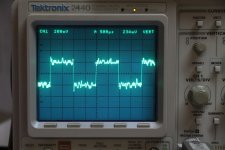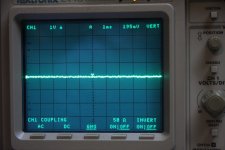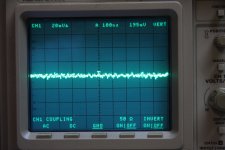I recently bought a TEK2440 scope and it's hexibiting lot of rippling even when GND'ed. I cannot even have the probe calibration square wave "unrippled".
It apears on both channels. The Self Cal and the Self Diag routines are successful.
Is it a problem that's easy to fix?
See pics.
Regards,
MArtin.
It apears on both channels. The Self Cal and the Self Diag routines are successful.
Is it a problem that's easy to fix?
See pics.
Regards,
MArtin.
Attachments
I have the same scope and it does not have that 'feature'.
Looking at your pix, that looks like noise rather than ripple so look for external sources of noise and\or interference. Make sure you have a good ground, move the scope to different locations and see if the interference changes. It is random rather than repetitive so it is not what you would call ripple in the classic sense.
I'll fire mine up today and see if I can figure anything out to help you.
Looking at your pix, that looks like noise rather than ripple so look for external sources of noise and\or interference. Make sure you have a good ground, move the scope to different locations and see if the interference changes. It is random rather than repetitive so it is not what you would call ripple in the classic sense.
I'll fire mine up today and see if I can figure anything out to help you.
Last edited:
I agree it looks like parasitic HF noise. I tried in 3 different locations (3 buildings) with the same result. I wonder if theere's any filtering cap defective inside or something...
Beside that it's working good, but all my readings cannot be precise as that parasitic noises appear like ringing on real-world traces.
I'm just wondering if it's easily repairable or if I should just return it and wait for another opportunity.
Beside that it's working good, but all my readings cannot be precise as that parasitic noises appear like ringing on real-world traces.
I'm just wondering if it's easily repairable or if I should just return it and wait for another opportunity.
It looks digital; quantized to 40, 80 and sometimes 120 mV, in your first pic, and to one-tenth those levels in your last pic (which is at one-tenth the v/div of the first pic). So you have three LSBs of random noise, regardless of the V/DIV setting. Might be a clue as to where in the circuit the problem is.
If you don't return it, you should ask in the TekScopes group, at yahoogroups.com (after first searching their archive).
If you can easily return it, then you probably should.
If you don't return it, you should ask in the TekScopes group, at yahoogroups.com (after first searching their archive).
If you can easily return it, then you probably should.
I recently bought a TEK2440 scope and it's hexibiting lot of rippling even when GND'ed. I cannot even have the probe calibration square wave "unrippled".
It apears on both channels. The Self Cal and the Self Diag routines are successful.
Is it a problem that's easy to fix?
See pics.
Regards,
MArtin.
This is a complex Digital Storage Ocilloscope incorporating a unique CCD analog
storage register feeding an A to D system, storage, processing and subsequent D to A conversion for displaying on the CRT. Is this an easy problem to fix ? No, I think that you should have a look at the Maintenance manual. Pretty much all the answers here are simplistic in terms of solving your problem. You could start with a complete internal calibration of the unit (not the Self Cal or Self Diag routines).
You could start with a complete internal calibration of the unit (not the Self Cal or Self Diag routines).
Yes I think that's what I'll do. But until then, it's doing its job and for the purpose of testing only audio bands, it does the job just right.
Thanks for the advices.
Martin.
No, it seems internal parasitic somehow leaking... Knowing that, and because I only use it for audio purpose, I just use it as is.
I'm not even certain that there's a problem with it as when I look at other DSO images, they never appear to be perfectly flatlined...
I adapted to it
I'm not even certain that there's a problem with it as when I look at other DSO images, they never appear to be perfectly flatlined...
I adapted to it
I don't know the 2440 well enough. But a common problem with the 2465 series is dried out caps in the power supply. The 2465B I have was in the surplus pile at work because it had failed calibration. I think at first, it wouldn't even turn on. There was an auto-shutoff that triggered and turned the scope off (AFAIR, it's been a while). When I did get it to turn on, the trace was very noisy - but in my case it was more of a fat band rather than the quantization noise you're seeing. It was caused by excessive ripple resulting from dried out caps. $20 later, I had a perfectly good working 400 MHz scope.
Don't adapt to broken tools. Just get the service manual and fix it. The CRT is good so you won't have to mess with high voltage circuits (aside from perhaps some mains voltage in the supply section). My bet is that you have a dead supply or bypass cap somewhere. Just replace them. They're cheap.
~Tom
Don't adapt to broken tools. Just get the service manual and fix it. The CRT is good so you won't have to mess with high voltage circuits (aside from perhaps some mains voltage in the supply section). My bet is that you have a dead supply or bypass cap somewhere. Just replace them. They're cheap.
~Tom
- Status
- This old topic is closed. If you want to reopen this topic, contact a moderator using the "Report Post" button.
- Home
- Design & Build
- Equipment & Tools
- TEK 2440 rippled !!?!


